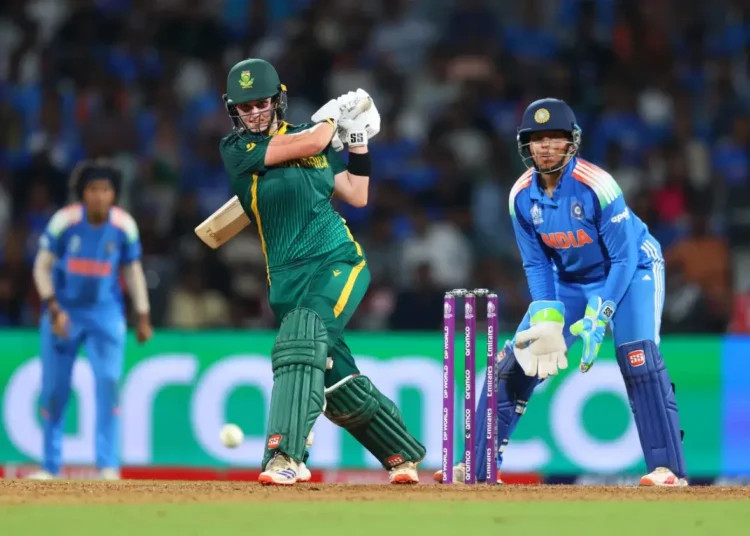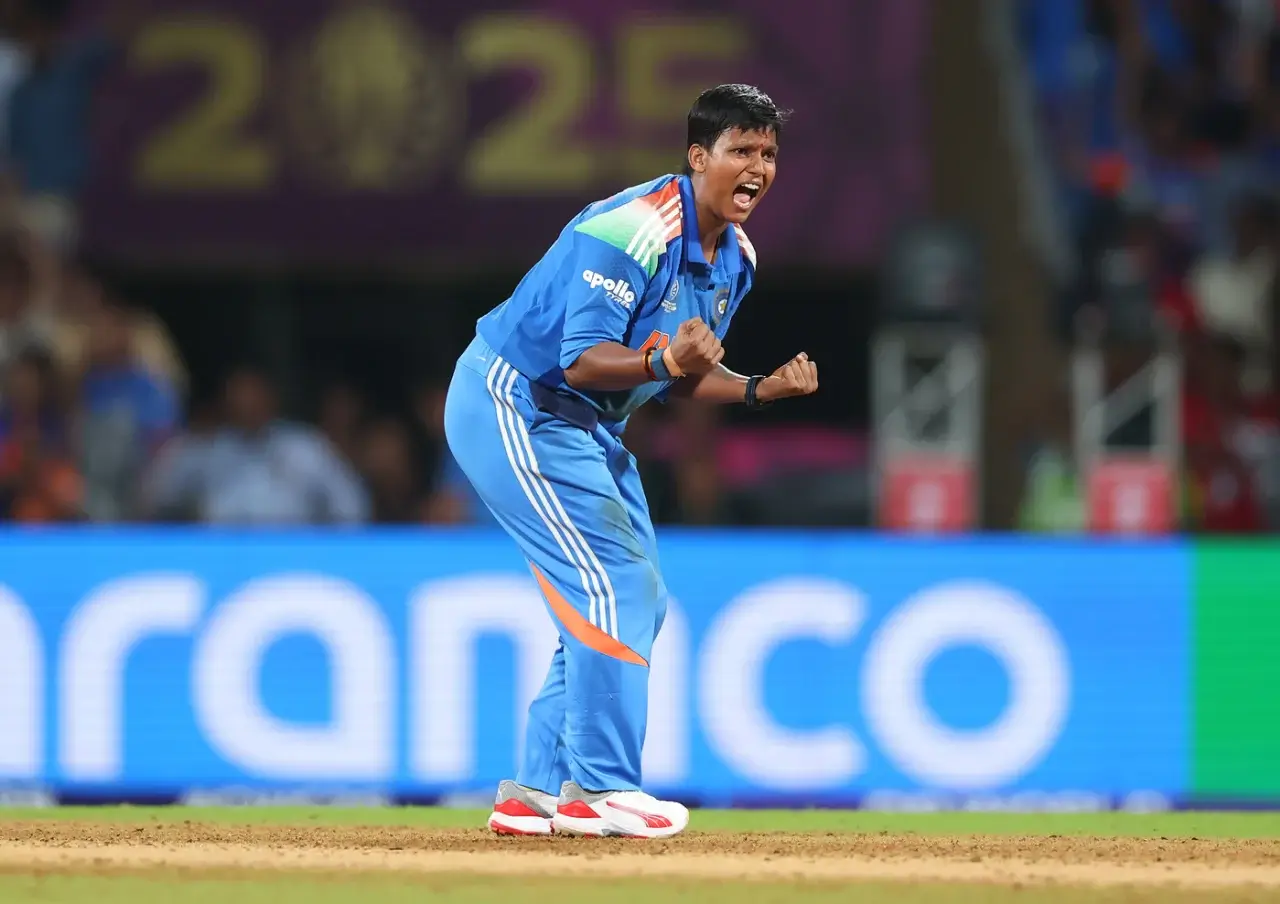Laura Wolvaardt has achieved what few thought possible during this World Cup. The South African captain has overtaken Smriti Mandhana to become the No.1 ranked batter in ICC’s ODI rankings. Her twin hundreds in the semi-final and final carried both South Africa’s campaign and her global reputation to new heights.
Wolvaardt’s 571 tournament runs created a new World Cup record, surpassing every previous tally in women’s ODI history. Her 169 against England in the semi-final and 101 in the final earned her 814 ranking points — three more than Mandhana’s 811. Those two knocks alone transformed the global batting hierarchy.
Mandhana had led the rankings throughout the tournament, but her lower scores in knockouts allowed Wolvaardt’s surge. Meanwhile, strong performances by Deepti Sharma, Jemimah Rodrigues, and Marizanne Kapp added depth to this year’s ranking shifts. The ICC updates released after the final confirmed multiple positional changes across batting, bowling, and allrounder lists.
As the dust settles on Navi Mumbai’s World Cup final, Wolvaardt’s name now sits where it belongs — at the very top. This change is more than statistical; it reflects dominance, consistency, and poise when pressure is at its peak.
Wolvaardt’s Record World Cup: The Performance That Changed Everything
For Laura Wolvaardt, this wasn’t just a successful tournament — it was career-defining. Her 571 runs at an average of 95 set a new global benchmark for tournament performance. The innings of 169 against England in the semi-final was artistry under pressure, combining patience, control, and clean striking. Two days later, her 101 in the final sealed her place as the most complete batter of the season.
Her method remains a lesson in controlled aggression. Wolvaardt starts slow, assesses field placements, and then builds momentum through timing rather than brute force. Each innings grows organically, reflecting technical assurance and mental strength. This approach explains her sharp rise in ICC ODI rankings, where consistency carries higher weight than isolated bursts of brilliance.
Mandhana, despite maintaining high form, couldn’t match Wolvaardt’s knockout peaks. The ICC algorithm assigns heavier ranking points to semi-final and final performances, magnifying Wolvaardt’s late-tournament surge. Her elevation to 814 points, a career-best, feels symbolic of South Africa’s growing stature in women’s cricket.
Beyond numbers, Wolvaardt’s calm leadership also influenced her side’s composure under pressure. She proved that elegance, patience, and determination can define a new generation of batting greatness.
Mandhana, Rodrigues, and Perry: The Chasers in Form
Smriti Mandhana may have lost her No.1 crown, but her dominance remains intact. Throughout the World Cup, she anchored India’s top order, guiding her side to crucial wins. Her tally of 492 runs secured second place on the overall list. The only blemish was her limited impact in the knockout rounds — 24 in the semi-final and 45 in the final.
While Mandhana held steady, Jemimah Rodrigues took her chance to shine. Her unbeaten 127 against Australia in the semi-final was a career highlight that pushed her nine places higher in the rankings to No.10. That innings combined control and aggression — the hallmark of a batter coming of age.
Ellyse Perry, meanwhile, reminded everyone of her elite class with 77 against India. That knock propelled her back into the top ten, tying with Sophie Devine in seventh place. Perry’s comeback also demonstrated why experience still matters on the biggest stage.
Even Phoebe Litchfield broke through, climbing thirteen spots to No.13 after a polished 119 in the semi-final. These gains underscore how high-impact innings during knockouts can significantly alter ranking charts. The chasers may have missed No.1, but they’ve set up a fierce race for 2026.
Bowling Rankings Reshuffle: Kapp and Sutherland Lead the Charge
If the batting charts had drama, the bowling tables saw a reshuffle of their own. Marizanne Kapp surged to No.2 after a sensational 5 for 20 in the semi-final against England. Her performance redefined South Africa’s bowling narrative — control, precision, and sheer will.
With that spell, Kapp now trails only Sophie Ecclestone, the ever-dominant England spinner. Kapp’s consistency across both seam and swing makes her the most versatile bowler of the year. The semi-final wickets earned maximum ICC rating points due to match situation and opposition strength.
Australia’s Annabel Sutherland and Kim Garth also climbed, showcasing the depth in their bowling unit. Sutherland now sits sixth, while Garth moved up to seventh. Both showed adaptability across different surfaces, handling Indian conditions with tactical clarity.
Meanwhile, Alana King dropped one position to third as Kapp’s rise displaced her. These shifts confirm how every performance in knockout matches matters for year-end ranking positions. For the first time in years, the top ten reflects true global variety — seamers, spinners, and allrounders from five nations sharing elite space.
Deepti Sharma and the Allrounder Revolution
India’s Deepti Sharma has become the face of the allrounder resurgence. Her seven wickets and 82 runs in the knockout phase propelled her to fourth among ICC allrounders. That rise took her above Annabel Sutherland, who had dominated earlier this year.
Deepti’s reliability gives India unmatched tactical flexibility. She anchors innings from the lower middle order and provides control through economical off-spin. Her composure under pressure made her the Player of the Tournament, cementing her as a cornerstone in India’s lineup.
What’s striking is how allrounders have regained prominence in modern women’s cricket. Multi-dimensional players like Kapp, Sutherland, and Deepti have become indispensable. Teams with three-dimensional contributors enjoy better balance, allowing deeper batting and aggressive bowling plans.
This new ranking order highlights a trend toward complete cricketers — those who adapt, perform, and deliver across formats. Deepti’s climb validates years of patient evolution, hard work, and understanding of game scenarios. The allrounder category now drives value both in ICC rankings and WPL auction strategy.
WPL Auction Impact: How Rankings Shape Market Value
World Cup success often precedes franchise bidding wars, and this year will be no different. Laura Wolvaardt’s rise to No.1 instantly elevates her WPL market value. Teams such as Gujarat Giants and Mumbai Indians are expected to revisit retention discussions.
Marizanne Kapp’s bowling heroics make her an automatic retention priority for Delhi Capitals. Likewise, Deepti Sharma’s allround value ensures she remains the first-choice marquee Indian. Annabel Sutherland and Ellyse Perry may now draw aggressive interest from multiple franchises looking for balance and leadership.
The Women’s Premier League relies on recent ICC form when valuing players. A top ranking not only boosts global recognition but also affects price brackets directly. For scouts and analysts, rankings now act as measurable data points to justify investment.
The link between ICC charts and franchise demand is stronger than ever. Expect Laura Wolvaardt, Deepti Sharma, and Kapp to headline auction boards. For younger players like Rodrigues and Litchfield, these numbers will open fresh doors of opportunity. The auction floor, like the rankings, rewards form, flair, and timing.
How Wolvaardt’s Rise Reflects the Global Shift in Women’s Cricket?
Wolvaardt’s ascent to No.1 isn’t just a personal triumph — it mirrors the evolution of modern women’s cricket. The gap between established and emerging nations has narrowed considerably. Performances from South Africa, India, and Australia prove global parity is finally here.
Wolvaardt’s journey from teenage prodigy to global captain symbolizes this transformation. Her approach blends technical perfection with mental steel, something traditionally associated with male batting icons. The women’s game today celebrates craft and temperament equally.
This ranking reshuffle highlights how competitiveness now extends far beyond the “Big Three.” Nations like Bangladesh, Sri Lanka, and West Indies are producing talents knocking on elite doors. The ICC’s transparent rating system amplifies these shifts and gives equal weight to all.
For young players worldwide, Wolvaardt’s story is inspiration made visible. Her success signals that opportunity favors preparation and consistency, not just name or geography. As the women’s game grows in coverage, depth, and audience, stories like hers shape its future narrative.
The Future of Rankings and Rivalries
The 2025–26 season promises thrilling battles across formats. Smriti Mandhana will target reclaiming her crown with renewed focus. Wolvaardt aims to sustain form across bilateral tours and WPL seasons. Deepti Sharma and Kapp will anchor their teams’ allround success.
Expect ranking volatility as upcoming series in Australia and New Zealand begin. Every innings, every spell will now carry direct implications for position shifts. The women’s rankings are finally dynamic, unpredictable, and globally inclusive — a reflection of the sport’s healthy competitiveness.
Conclusion
Laura Wolvaardt’s record-breaking World Cup run has done more than crown a new No.1. It has redefined what excellence in women’s cricket looks like. Her performances combined style with steel, artistry with impact, and grace with control. In doing so, she reminded the world that domination can come quietly — ball by ball, match by match.
Smriti Mandhana, Deepti Sharma, Marizanne Kapp, and others aren’t far behind. Their battles for top positions will drive future rivalries, narratives, and attention to women’s cricket. The ripple effect from this World Cup will shape upcoming series, WPL auctions, and global recognition.
This ranking reshuffle is more than statistics; it’s evolution in motion. It represents global diversity, growing standards, and the unstoppable rise of women’s cricket as a spectacle of skill and spirit. For now, the crown sits on Wolvaardt’s head — deservedly, confidently, and beautifully.







